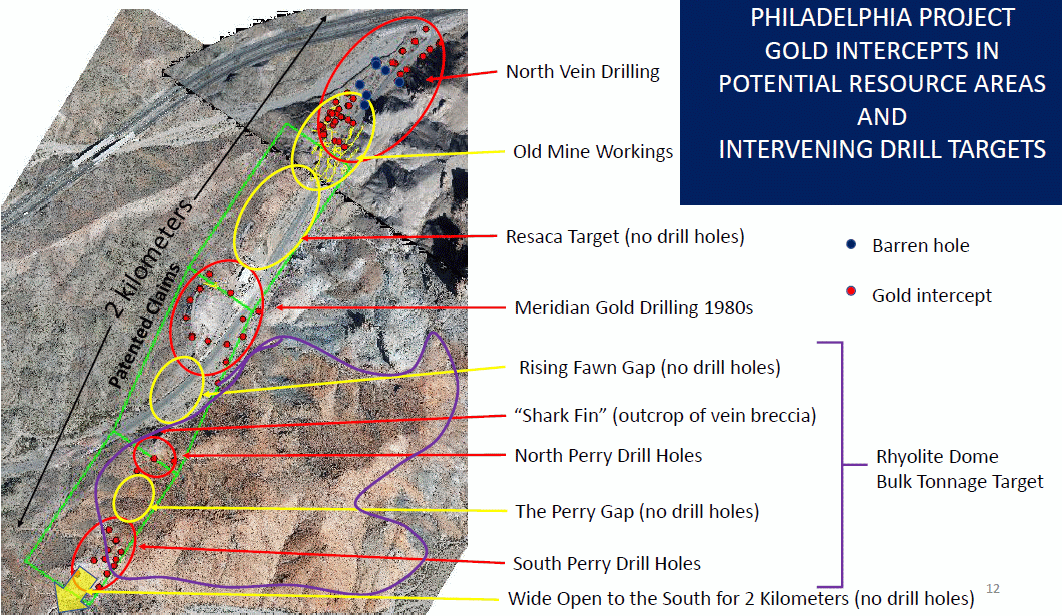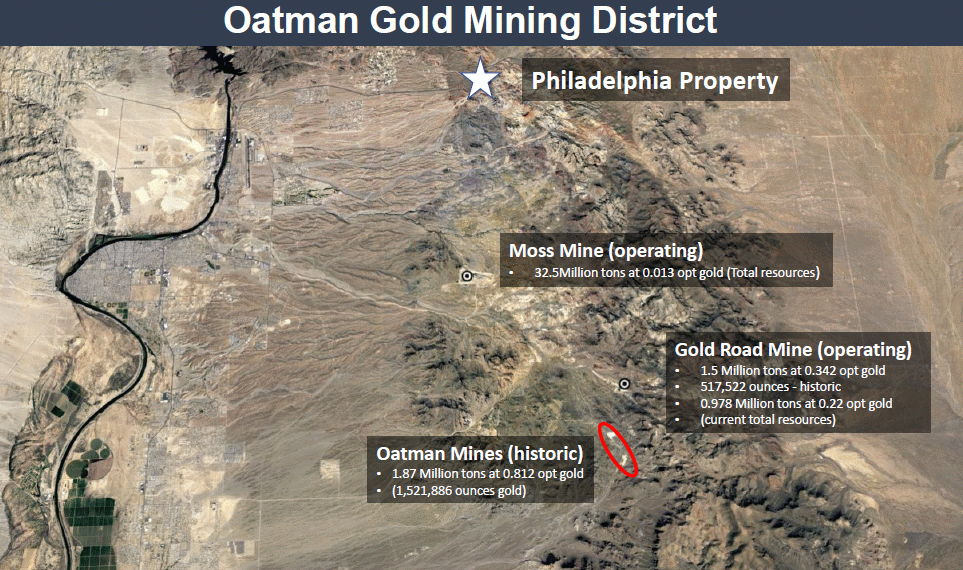|
Tracker - January 25, 2022: Spec Value Rating for Arizona Silver Corp
 Arizona Silver Corp was assigned a Bottom-Fish Spec Value rating at $0.20 on December 1, 2021 based on emerging evidence that the Philadelphia project in Arizona was evolving beyond a high grade gold-silver vein chasing exercise into a potential associated open-pittable bulk tonnage discovery. Arizona Silver listed on the TSXV on Nov 16, 2011 as a CPC called Damon Capital Corp which completed its QT on Nov 16, 2016 by acquiring a private company called Arizona Silver Corp with rights to the former Ramsey silver mine in Arizona. The driving force behind Arizona Silver was Mike Stark who handled marketing and is now the CEO, and Greg Hahn who handles the exploration strategy. Arizona Silver Corp was assigned a Bottom-Fish Spec Value rating at $0.20 on December 1, 2021 based on emerging evidence that the Philadelphia project in Arizona was evolving beyond a high grade gold-silver vein chasing exercise into a potential associated open-pittable bulk tonnage discovery. Arizona Silver listed on the TSXV on Nov 16, 2011 as a CPC called Damon Capital Corp which completed its QT on Nov 16, 2016 by acquiring a private company called Arizona Silver Corp with rights to the former Ramsey silver mine in Arizona. The driving force behind Arizona Silver was Mike Stark who handled marketing and is now the CEO, and Greg Hahn who handles the exploration strategy.

Ramsey hosted a narrow high grade silver vein that was mined on a very small scale because its down-dip extension was cut off by a fault. Hahn developed the hypothesis that the remainder of the system had been fault offset to the northeast where it was buried under gravel cover. An IP anomaly suggested a comparison with the Real de Angeles deposit in Zacatecas where a high grade silver-lead-zinc vein ended up being the extension of a bulk tonnage system that became an open pit mine. May 18, 2017 outlined this play which caught the market's imagination, but the play collapsed when rush assays revealed that the silver grade was too low. I gave up in Tracker Jan 17, 2018. Arizona Silver still has hopes for testing a blind geophysical target to the east of the Ramsey vein interpreted as a bulk tonnage system, but Philadelphia has become the primary focus.
After killing the deep IP Ramsey target Arizona Silver in March 2018 optioned the Sycamore Canyon project in Arizona which a pair of prospectors had generated during the 1980's but never managed to do any work on themselves or farm it out. Greg Hahn knew one of them and optioned the claims whose outcropping gold-silver mineralized breccia zones have never been drilled. However, it lies in USFS jurisdiction and when they initiated the drill permitting cycle in 2019 the wheels got immediately gummed up by the covid pandemic in 2020. Arizona Silver is still awaiting a drill permit but Sycamore Canyon is secondary to Philadelphia optioned in February 2019.

The Philadelphia lease covered 11 unpatented claims in Arizona's Oatman district, the northeast extension of the high grade low sulphidation epithermal Philadelphia-Arabian gold-silver vein. These claims were worked in 1917-1941 via 2 shafts and a 50 tpd mill. Initially Arizona Silver tried to find shoots between the mined out portions and then chase the existing shoots beyond the 125 m mining depth limit. This was a truly uninteresting exploration story with no scale so I ignored it. The southern part of the vein was covered by 3 patented claims being worked on a mom and pop scale. AZS leased the Perry claim in Feb 2021 and then the Resaca and Rising Fawn claims in Aug 2021 so that it controlled the entire vein. It also staked a buffer zone around the claims in 2021, including the 1 km by 1 km square jutting east of the 3 patented claims acquired in 2021. This was done for a reason that finally makes the Philadelphia project interesting and Arizona Silver Corp worthy of a Bottom-Fish Spec Value rating.

Arizona Silver drilled the just acquired Perry claim in Q2 of 2021 and intersected high grade gold-silver values over 1.5-9 m intervals within the vein below the projected boiling zone within this system. But the big surprise in the Perry claim area was that both the footwall and particularly the hanging wall had thick intervals of low grade stockwork mineralization which is absent at the northern Philadelphia vein end of the system where Arizona Silver had focused its drilling efforts in 2019-2020. These results prompted Greg Hahn to rethink the deposition model for the Philadelphia project.

The Philadelphia vein tracks the fault contact with basement rocks to the west of a volcanic rhyolite flow dome complex centered east of the Perry claim area. The vein does not outcrop on most of the Perry claim but does to the northeast and to the southwest; Hahn now believes that the erosional surface is such that the southwest extension which is weakly mineralized is above the boiling zone while the northern extension is below it. But in the middle segment covered by the 3 patented claims acquired in 2021 the boiling zone is close to the surface. Not only does this now provide a guide for tracking the unmined portion the Philadelphia vein at depth and along strike, but it opens up the potential for a low grade stockwork zone just below the boiling zone of the dome complex to the east. This was confirmed on Dec 9, 2021 when AZS received assays for the upper portions of 2 Perry holes.

Arizona Silver is gearing up to mount a major core drilling program which will test two objectives: 1) delineate the Philadelphia vein estimated with average 5 m thickness to a depth of 200 m along a 400 m segment of the Perry claim including a 200 m gap in the middle caused by lack of drill roads, and, 2) assess a 100 m thick envelope around the vein as a bulk tonnage target. The vein target represents a 1 million tonne footprint where a 10 g/t gold grade would represent about 320,000 ounces. The disseminated target has a tonnage footprint of 200 million tonnes which at 1 g/t would represent about 640,000 ounces. If this combination were to exist it could be at least partly mined as an open pit. If it extends farther east it could become very interesting.

The scope of the initial drill program is limited by the footprint of the patented claims and their easier permitting. The next stage which is subject to BLM permits would involve stepping to the east to chase the vein deeper and assess how the low grade stockwork mineralization behaves laterally within the rhyolite flow dome and within reach of open-pittable depth. A future stage would involve drilling the 1,500 m southwestern extension of the Philadelphia vein whose bonanza grades are expected to be deeper and which have never been drilled.

Arizona Silver Corp has 76.7 million fully diluted after raising $945,000 in December 2021 through a half warrant unit at $0.21, which brings its working capital to about $1.2 million. The missing pieces are confirmation of the bulk tonnage scenario and sufficient funding to allow systematic drilling of this 3,500 m by 300-1,300 m wide land package. Arizona Silver has enough money to get this program underway in H1 of 2022, but will need to raise additional money, though this should not be a problem if results support the new rethink of the Philadelphia system's potential for both high grade and bulk tonnage gold mineralization. Sycamore Canyon could become a fallback play if Philadelphia disappoints, but the USFS needs to grant those drill permits. The market probably will not want to hear about the Ramsey project until after drill results confirm a new zone to the east of the original Ramsey workings. Arizona Silver does have drill permits for the Silverton project in central Nevada where an undrilled portion has potential for a Carlin-type gold system, though that project might end up be farmed out. A consolation prize for the Philadelphia play if it does not deliver results supportive of a standalone mine could involvee becoming part of an Oatman District consolidation effort. Elevation Gold Mining Corp operates the Moss gold mine to the south and is in need of a redemption story after merging with Eclipse Gold Mining Corp in February 2021, and could benefit from higher grade mill feed. Alternatively that district consolidation could be pursued by Aura Minerals Inc which operates the Gold Road Mine acquired in 2020.
|